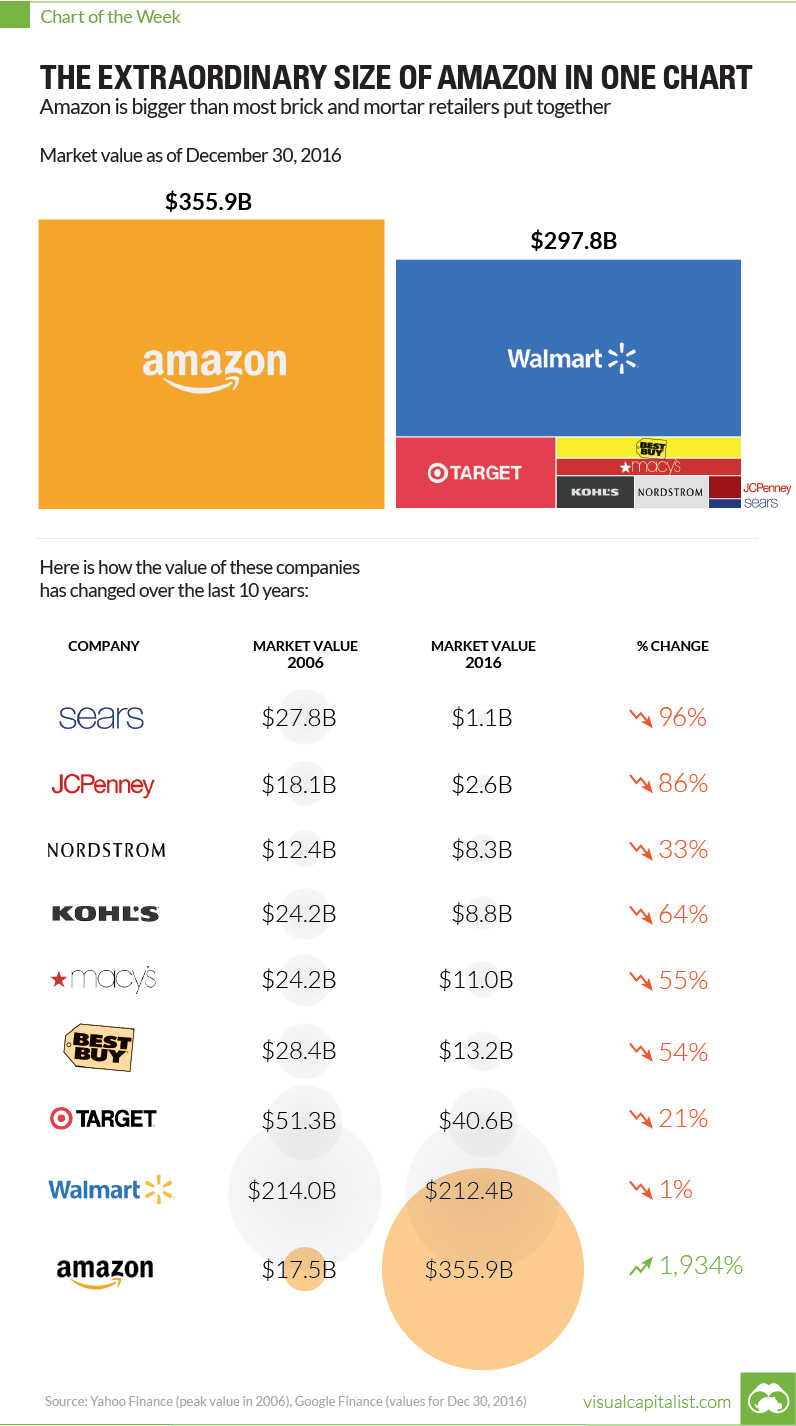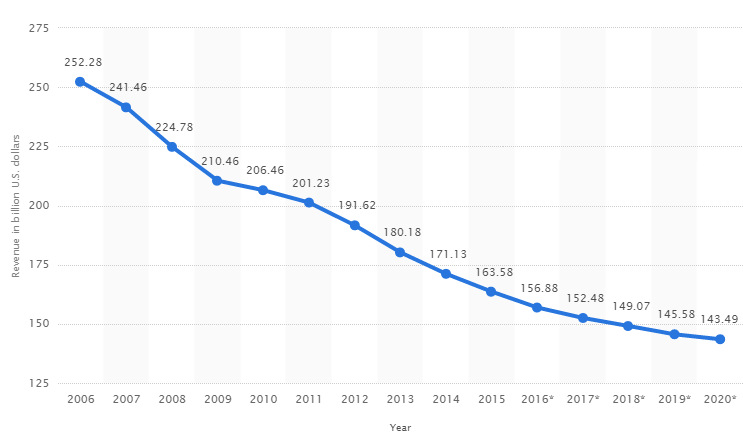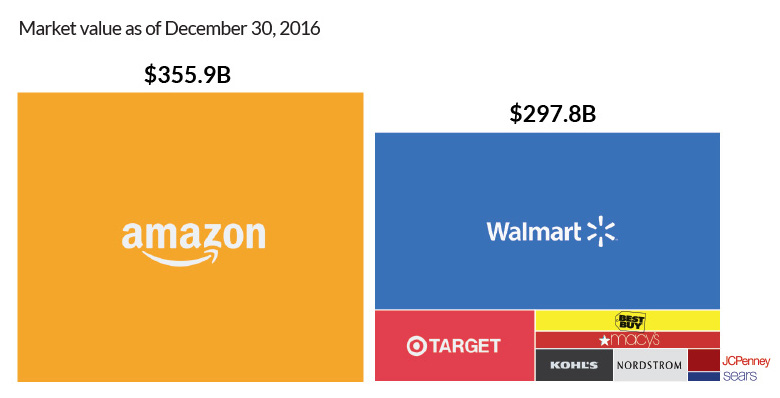Technology
The Extraordinary Size of Amazon in One Chart

The Extraordinary Size of Amazon in One Chart
It’s bigger than most brick and mortar retailers together
The Chart of the Week is a weekly Visual Capitalist feature on Fridays.
What has more value: all major publicly traded department stores in the United States, or Amazon?
Amazon takes the cake, and its no contest.
Add together the market caps of Walmart, Target, Best Buy, Nordstrom, Kohl’s, JCPenney, Sears, and Macy’s, and they amount to a significant $297.8 billion:
| Brick & Mortar Store | 2016 Value ($B) |
|---|---|
| Sears | $1.1 |
| JCPenney | $2.6 |
| Nordstrom | $8.3 |
| Kohl's | $8.8 |
| Macy's | $11.0 |
| Best Buy | $13.2 |
| Target | $40.6 |
| Walmart | $212.4 |
| Total | $297.8 |
However, it’s not enough to beat the Amazon machine.
The online retailer alone is worth $356 billion, making it one of the largest companies by market capitalization in the world.
The Death of Traditional Retail
Ten years ago, the future of brick and mortar retail sill looked bright. The aforementioned retailers were worth a collective $400 billion, and Amazon was only valued at $17.5 billion.
But disruption often comes without warning. Or if there were warning signs, they went unheeded by retailers.
Big box and department store sales plummeted, as consumers increasingly went online to do their shopping. This year, it is estimated that revenues are equal to just 62% of their totals in 2006:
Big Box and Department Store Sales ($ Billion)

Retailers without the right strategy saw their market caps plummet.
Sears went from being worth $27.8 billion to $1.1 billion (a 96% decrease), while JCPenney went from $18.1 billion to $2.6 billion (a 86% decrease).
Here’s the full damage over the last 10 years to brick and mortar stores:
| Store | 2006 Value ($B) | 2016 Value ($B) | % Change |
|---|---|---|---|
| Sears | $27.8 | $1.1 | -96% |
| JCPenney | $18.1 | $2.6 | -86% |
| Nordstrom | $12.4 | $8.3 | -33% |
| Kohl's | $24.2 | $8.8 | -64% |
| Macy's | $24.2 | $11.0 | -55% |
| Best Buy | $28.4 | $13.2 | -54% |
| Target | $51.3 | $40.6 | -21% |
| Walmart | $214.0 | $212.4 | -1% |
| Total | $400.4 | $297.8 | -26% |
Amazon, on the other hand, did okay for itself.
The online retailer gained 1,934% in value over the same timeframe, making it one of the most valuable companies in the world, and a key piece of Jeff Bezos’ business empire.
Brands
How Tech Logos Have Evolved Over Time
From complete overhauls to more subtle tweaks, these tech logos have had quite a journey. Featuring: Google, Apple, and more.

How Tech Logos Have Evolved Over Time
This was originally posted on our Voronoi app. Download the app for free on iOS or Android and discover incredible data-driven charts from a variety of trusted sources.
One would be hard-pressed to find a company that has never changed its logo. Granted, some brands—like Rolex, IBM, and Coca-Cola—tend to just have more minimalistic updates. But other companies undergo an entire identity change, thus necessitating a full overhaul.
In this graphic, we visualized the evolution of prominent tech companies’ logos over time. All of these brands ranked highly in a Q1 2024 YouGov study of America’s most famous tech brands. The logo changes are sourced from 1000logos.net.
How Many Times Has Google Changed Its Logo?
Google and Facebook share a 98% fame rating according to YouGov. But while Facebook’s rise was captured in The Social Network (2010), Google’s history tends to be a little less lionized in popular culture.
For example, Google was initially called “Backrub” because it analyzed “back links” to understand how important a website was. Since its founding, Google has undergone eight logo changes, finally settling on its current one in 2015.
| Company | Number of Logo Changes |
|---|---|
| 8 | |
| HP | 8 |
| Amazon | 6 |
| Microsoft | 6 |
| Samsung | 6 |
| Apple | 5* |
Note: *Includes color changes. Source: 1000Logos.net
Another fun origin story is Microsoft, which started off as Traf-O-Data, a traffic counter reading company that generated reports for traffic engineers. By 1975, the company was renamed. But it wasn’t until 2012 that Microsoft put the iconic Windows logo—still the most popular desktop operating system—alongside its name.
And then there’s Samsung, which started as a grocery trading store in 1938. Its pivot to electronics started in the 1970s with black and white television sets. For 55 years, the company kept some form of stars from its first logo, until 1993, when the iconic encircled blue Samsung logo debuted.
Finally, Apple’s first logo in 1976 featured Isaac Newton reading under a tree—moments before an apple fell on his head. Two years later, the iconic bitten apple logo would be designed at Steve Jobs’ behest, and it would take another two decades for it to go monochrome.
-

 Travel1 week ago
Travel1 week agoAirline Incidents: How Do Boeing and Airbus Compare?
-

 Markets3 weeks ago
Markets3 weeks agoVisualizing America’s Shortage of Affordable Homes
-

 Green3 weeks ago
Green3 weeks agoRanked: Top Countries by Total Forest Loss Since 2001
-

 Money2 weeks ago
Money2 weeks agoWhere Does One U.S. Tax Dollar Go?
-

 Misc2 weeks ago
Misc2 weeks agoAlmost Every EV Stock is Down After Q1 2024
-

 AI2 weeks ago
AI2 weeks agoThe Stock Performance of U.S. Chipmakers So Far in 2024
-

 Markets2 weeks ago
Markets2 weeks agoCharted: Big Four Market Share by S&P 500 Audits
-

 Real Estate2 weeks ago
Real Estate2 weeks agoRanked: The Most Valuable Housing Markets in America















